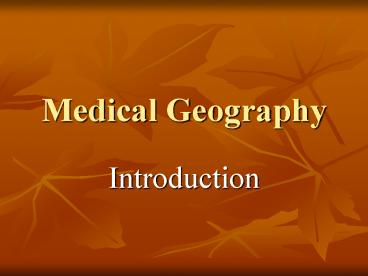Medical Geography - PowerPoint PPT Presentation
Title:
Medical Geography
Description:
Medical Geography Introduction Medical Geography Developed from the work of Dr. John Snow Trying to stop the transmission of cholera 1854- outbreak of cholera in ... – PowerPoint PPT presentation
Number of Views:79
Avg rating:3.0/5.0
Title: Medical Geography
1
Medical Geography
- Introduction
2
Medical Geography
- Developed from the work of Dr. John Snow
- Trying to stop the transmission of cholera
- 1854- outbreak of cholera in London
- Dr. Snow plotted the deaths from cholera on a
map, determining an unusually high number of
deaths were linked with a particular water pump-
on Broad St. - He petitioned to have the pump closed, which led
to a drastic decrease in new cholera deaths. - One of most famous and earliest instances of
using maps to understand spread of disease
3
Snows Cholera map
4
Worldwide causes of death
- medical geographers measure health strictly in
terms of morbidity (illness and disease
complications) and mortality (death). - In addition to diffusion over space, they also
focus on diffusion over time- known as
spatio-temporal mapping and analysis
Developed countries
Developing countries
5
Definitions
- epidemiology - study of occurrence, distribution,
and control of diseases in populations - origin, spread or communication, and eradication
of disease - incidence - number of diseased individuals in a
defined population - endemic - constantly present disease
- epidemic - abnormally high incidence locally
- pandemic - abnormally high incidence over a wide
geographic area (worldwide?) - vector- agent used as a vehicle for transfer.
- (disease vector agent that transfers a pathogen
from one organism to another (e.g., an insect))
can also be viral, including a live virus used as
an antigen delivery vehicle in a vaccine
6
(No Transcript)
7
(No Transcript)
8
(No Transcript)
9
(No Transcript)
10
Recent worldwide outbreaks of disease
11
Historical aspects
- Paleolithic- low populations/ good diets keep
diseases from becoming endemic - Neolithic- population density increases, animal
domestication occurs, diets deteriorated
(dependence on grains mainly), water borne
diseases - Imperial period- trade increases, urban areas
become more unhealthy - Medieval- plague, trade decreases, population
decreases, epidemics frequent but less virulent - Exploration- introduction of disease to virgin
populations, trans-Atlantic slave trade
12
More Historical geographies
- Industrial Age- more trade-gt more diffusion of
disease, urban slums (diet and exhaustion),
endemic diseases become childhood ones, rapid
population growth, hygiene - Today
Factors Contributing To New Infections
- Population Growth
- Urbanization
- Expansion Into New Areas
- Ecological Changes
- Reduced Biodiversity
- Microbial And Vector Resistance
- Water Pollution
- Global Warming
- Ozone Hole
- Public Health Deficiencies
- War
- Transport
- Other Changes
13
Risks?
- Complacency with endemic disease?
- Non-vaccinated groups?
- Antibiotic resistant strains?
- New Epidemics?
- Danger related to means of transmission
- Direct contact (person to person) containable
- Water and food borne- contained with adequate
public health measures - more difficult to control vectors.
- Air-borne diseases pose the greatest threat.
- Influenza greatest threat?
- Germ warfare?
14
Control of Epidemics
- Improved resistance
- Improve nutrition reduce population
concentrations lighter work loads - Control Reservoir
- Reduce mosquitoes and their breeding grounds
- immunize animals (e.g. rabies)
- Control transmission
- direct contact (including STDs)
- Food, water, air, feces
- Immunizations
- Recommended for Foreign Travel
- cholera, yellow fever, plague, infectious
hepatitis A, serum hepatitis B, typhoid fever,
malaria































